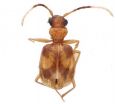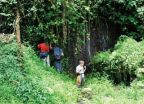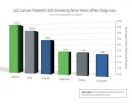(Press-News.org) An extensive study by Smithsonian scientists presents a synopsis of the carabid beetle tribe Lachnophorini. The research contains a new genus and the remarkable 24 new species added to the tribe. The study was published in the open access journal ZooKeys.
Beetles from the family Carabidae, commonly known as ground beetles are a large, cosmopolitan group, with more than 40,000 species worldwide, Carabid beetles range in size from 0.6 mm to 90.2 mm and occur in nature in several fractal universes influencing life therein as predators, ectoparasitoids, seed eaters, and even fungal mycelia feeders in a multitude of ways.
Understanding the impact of this beetle family's importance across a multidimensional landscape in a cascade of fractal universes is our biodiversity challenge for the 21st century for one of insects' most diverse families.
"For a fairly large and diverse Tribe of Carabidae with markedly interesting body forms and divergent ways of life, the Lachnophorini have all but been largely ignored by carabidologists until now. This new study establishes the groundwork for more refined studies aiming for a better understanding of the diversity of the species and the evolution of the tribe in order to have a finer awareness of the next smaller fractal universe for the Carabidae family, if we are truly to understand it." explains one of the authors Laura Zamorano, research student at the National Museum of Natural History, Smithsonian Institution.
This research is the beginning of series of steps towards the provision of taxonomic relationships of carabid beetles. For the near future the path forward to be followed will lead to an attempt, using morphological and molecular attributes to provide a firm basis for firm classification.
INFORMATION:
Original Source:
Erwin TL, Zamorano LS (2014) A synopsis of the tribe Lachnophorini, with a new genus of Neotropical distribution and a revision of the Neotropical genus Asklepia Liebke, 1938 (Insecta, Coleoptera, Carabidae). ZooKeys 430: 1-108. doi: 10.3897/zookeys.430.8094
A synopsis of the carabid beetle tribe Lachnophorini reveals remarkable 24 new species
2014-08-06
ELSE PRESS RELEASES FROM THIS DATE:
Study: arctic mammals can metabolize some pesticides, limits human exposure
2014-08-06
Fortunately, you are not always what you eat – at least in Canada's Arctic.
New research from the University of Guelph reveals that arctic mammals such as caribou can metabolize some current-use pesticides (CUPs) ingested in vegetation.
This limits exposures in animals that consume the caribou – including humans.
"This is good news for the wildlife and people of the Arctic who survive by hunting caribou and other animals," said Adam Morris, a PhD student in the School of Environmental Sciences and lead author of the study published recently in Environmental Toxicology ...
New material structures bend like microscopic hair
2014-08-06
CAMBRIDGE, MA -- MIT engineers have fabricated a new elastic material coated with microscopic, hairlike structures that tilt in response to a magnetic field. Depending on the field's orientation, the microhairs can tilt to form a path through which fluid can flow; the material can even direct water upward, against gravity.
Each microhair, made of nickel, is about 70 microns high and 25 microns wide — about one-fourth the diameter of a human hair. The researchers fabricated an array of the microhairs onto an elastic, transparent layer of silicone.
In experiments, the ...
Coping skills help women overcome the mental anguish of unwanted body evaluation and sexual advances
2014-08-06
Some young women simply have more resilience and better coping skills and can shrug off the effect of unwanted cat calls, demeaning looks and sexual advances. Women with low resilience struggle and could develop psychological problems when they internalize such behavior, because they think they are to blame. So say Dawn Szymanski and Chandra Feltman of the University of Tennessee in the US, in Springer's journal Sex Roles, after studying how female college students handle the sexually objectifying behavior of men.
According to the popular feminist Objectification Theory, ...
Curing arthritis in mice
2014-08-06
Rheumatoid arthritis is a condition that causes painful inflammation of several joints in the body. The joint capsule becomes swollen, and the disease can also destroy cartilage and bone as it progresses. Rheumatoid arthritis affects 0.5% to 1% of the world's population. Up to this point, doctors have used various drugs to slow or stop the progression of the disease. But now, ETH Zurich researchers have developed a therapy that takes the treatment of rheumatoid arthritis in mice to a new level: after receiving the medication, researchers consider the animals to be fully ...
Job insecurity in academia harms the mental wellbeing of non-tenure track faculty
2014-08-06
Non-tenure-track academics experience stress, anxiety, and depression due to their insecure job situation, according to the first survey of its kind published in the open-access journal Frontiers in Psychology.
There were 1.4 contingent faculty workers in the USA, according to a report by the American Association of University Professors. These faculty members, such as research adjunct faculty, lecturers and instructors, are off the so-called "tenure track". They work under short-term contracts with limited health and retirement benefits, often part-time and at different ...
Preparing for a changing climate: Ecologists unwrap the science in the National Climate Change Assessment
2014-08-06
Two Ignite sessions focusing on findings in the United States National Climate Assesment5 (NCA) will take place on Monday, August 11th during the Ecological Society of America's 99th Annual Meeting, held this year in Sacramento, California.
The first session, Ignite 1: From Plains to Oceans to Islands: Regional Findings from the Third National Climate Assessment will highlight major findings from the report about the regional effects of climate change, discuss impacts to the ecosystems of the region, and explore how changes in those ecosystems can moderate or exacerbate ...
Triangulum galaxy snapped by VST
2014-08-06
Messier 33, otherwise known as NGC 598, is located about three million light-years away in the small northern constellation of Triangulum (The Triangle). Often known as the Triangulum Galaxy it was observed by the French comet hunter Charles Messier in August 1764, who listed it as number 33 in his famous list of prominent nebulae and star clusters. However, he was not the first to record the spiral galaxy; it was probably first documented by the Sicilian astronomer Giovanni Battista Hodierna around 100 years earlier.
Although the Triangulum Galaxy lies in the northern ...
Study: Many cancer survivors smoke years after diagnosis
2014-08-06
ATLANTA – August 6, 2014–Nearly one in ten cancer survivors reports smoking many years after a diagnosis, according to a new study by American Cancer Society researchers. Further, among ten cancer sites included in the analysis, the highest rates of smoking were in bladder and lung cancers, two sites strongly associated with smoking. The study appears early online in Cancer Epidemiology, Biomarkers & Prevention.
Cigarette smoking decreases the effectiveness of cancer treatments, increases the probability of recurrence, and reduces survival time. Nonetheless, some studies ...
Nearly 10 percent of patients with cancer still smoke
2014-08-06
PHILADELPHIA — Nine years after diagnosis, 9.3 percent of U.S. cancer survivors were current smokers and 83 percent of these individuals were daily smokers who averaged 14.7 cigarettes per day, according to a report in Cancer Epidemiology, Biomarkers & Prevention, a journal of the American Association for Cancer Research (AACR).
"We need to follow up with cancer survivors long after their diagnoses to see whether they are still smoking and offer appropriate counseling, interventions, and possible medications to help them quit," said Lee Westmaas, PhD, director of tobacco ...
Healthy diet set early in life
2014-08-06
Promoting a healthy diet from infancy is important to prevent childhood obesity and the onset of chronic disease.
This is the finding from a study published in the latest issue of Australian and New Zealand Journal of Public Health.
Led by Rebecca Byrne from QUT, the study described quantity and diversity of food and drinks consumed by children aged 12-16 months.
"The toddler years are a critical age in the development of long-term food preferences, but this is also the age that autonomy, independence and food fussiness begins," Ms Byrne said.
"Childhood obesity in ...



